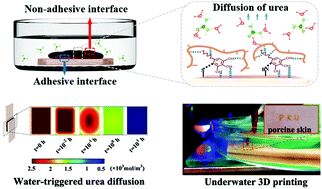Strong underwater adhesion of injectable hydrogels triggered by diffusion of small molecules†
Abstract
It is challenging for injectable hydrogels to achieve high underwater adhesiveness. Based on this concern, we report a fully physically crosslinked injectable hydrogel composed of gelatin, tea polyphenols and urea, capable of realising smart adhesion to various materials, like glass and porcine skin, in diverse aqueous environments. The urea molecules are designed as crosslinking disruptors for interfering with the formation of hydrogen bonds in the hydrogel, therefore modulating its crosslinking density and mechanical properties such as tensile strength, toughness and adhesive strength. Triggered by physical diffusion of the urea molecules towards the surrounding liquid environment, the hydrogel can achieve efficient (∼10 s), self-strengthening and long-lasting (>2 weeks) underwater adhesion. Remarkably, for fresh porcine skin, the instantaneous underwater adhesive strength is 10.4 kPa whereas the peak strength is as high as 152.9 kPa with the aid of the self-strengthening effect. More interestingly, it can simultaneously form controllable underwater non-adhesive surfaces, regulated by changes in the diffusion-triggered local concentration of urea. Further, it is also biocompatible, antibacterial, biodegradable and 3D printable in water, which offers great convenience for various applications concerning smart interfacial adhesion, like biomedicine and flexible electronics. Likewise, the physical diffusion-mediated mechanism represents an innovative strategy for developing next-generation smart hydrogels.



 Please wait while we load your content...
Please wait while we load your content...